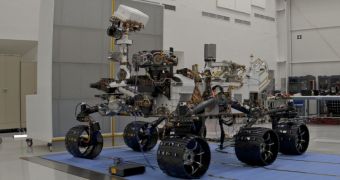According to Space, the Mars Science Laboratory (MSL) mission did not undergo one of the steps in the planetary protection guidelines NASA employs in order to ensure that no cross-contamination occurs during space exploration missions.
One of the things experts want to avoid when sending a mission to scout for life on other planets is to unwillingly carry life with the exploration robot itself. In order to ensure that this does not happen, NASA has a series of strict protocols set in place.
Yet, one of the steps in this clean-up process may have been omitted for the MSL. It is now too late to do anything about it, since the mission launched to the Red Planet on November 26. Apparently, it was all an issue of miscommunication, NASA officials say.
The Curiosity rover will use a series of three drill bits to conduct studies in Martian soils. In theory, these bits should have been put through an ultra-intensive clean-up process, before being placed inside a sterile box. The robotic arm on the rover would have taken them out once on Mars.
However, there were two errors in this plan. The team handling the bits did not put them through the final clean-up step required by NASA protocols, and the agency's planetary protection officer, Catharine Conley, only heard about this when it was too late.
“They didn't submit the request for the deviation not to comply with their planetary protection plan until several months ago,” she says. During the launch preparations, the sterile box was opened, and one of the drill bits attached to one of Curiosity's drilling instruments directly.
“That's where the miscommunication happened. I will certainly expect to have a lessons-learned report that will indicate how future projects will not have this same process issue,” Conley explains.
“I'm sure that the Mars exploration program doesn't want to have a similar process issue in the future. We need to make sure we do it right,” she adds. At the same time, the errors were supported by other MSL officials.
They argued that the machine would not be reaching any buried water-ice with its drill bits. As a mission destined to study Martian geological history, MSL is entirely prohibited from going anywhere near areas that have water-ice less than 1 meter (3.3 feet) under the surface.
The issue here is that microorganisms can withstand space travel. If Curiosity is contaminated, then it would deposit lifeforms originating on Earth on the Martian surface. Future missions might then mistakenly believe that life exists on the Red Planet.

 14 DAY TRIAL //
14 DAY TRIAL //